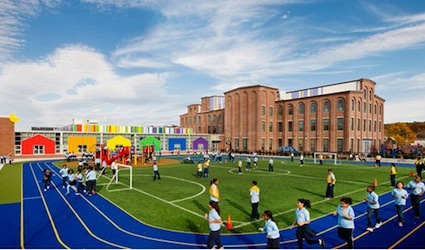Boston School Gives Students Play Area

CAMBRIDGE, Mass. — Designed by Cambridge, Mass.-based design firm HMFH Architects Inc., the Boston Renaissance Charter Public School project involved converting a historic industrial property into the modern, sustainable teaching environment desired by school administrators, with a focus on the school’s play spaces and recreation areas.
As an urban school, the design team was challenged to not only make each piece useful, but to also ensure that it was available for all 880 students every day.
Making the best use of the site to provide all students daily outdoor access required careful planning, officials said. An assortment of play structures designed to address a range of needs and abilities, a play field and running track, plus free-play areas make up the Renaissance "school yard."
The largest charter school project to be built in the Commonwealth to date, the design firm was responsible for a 15,000-square-foot addition and renovations to two buildings, including a 70,000-square-foot, historic timber and masonry mill building built in 1889 to house the school’s kindergarten through sixth grade program.
The structures occupy a six-acre industrial site and replace Boston Renaissance’s previous Park Square location — a 16-story high-rise building in downtown Boston that presented challenges to the school’s operations, according to Craig Engerman, chief operating officer at the school.
"There were no playgrounds for students, no parking for staff — the vertical structure presented logistical challenges for us," he said. "Getting students to classes, to lunch, and arrivals and dismissals in a vertical building is just difficult."
Students previously played games on the 25-foot-wide sidewalk outside the school, officials from the design firm said.
"We wanted a site no more than three stories, with play space for kids to go out and play and run and jump," Engerman said.
After conducting a feasibility study, the school’s board of trustees approved the purchase of the new Hyde Park site as well as a leaseback sale of the Park Square property, which allowed the school to operate while the new facility was renovated and expanded.
The high-rise space sold in 2008 and the new location opened in the fall of 2010 after construction ended in August 2010.
Engerman said there have been no issues at the new school.
"We have a beautiful facility," he said.
The school is divided into three age groups and houses most of the classrooms in the three-story mill building. Each of the age groups occupies a separate floor of the mill building.
The warehouse building, which has high ceilings and wide column spacing, provides large public and assembly spaces, including the gym, cafetorium, library, music classrooms and dance studios. The new addition contains an administration suite, support facilities and some of the Kinder classrooms.
Sustainable elements include the use of natural daylighting and an automated dimming system for artificial lights.
Pip Lewis, principal with HMFH, said the school’s priority for the play area was a safe, nurturing environment for the students — many of who come from underprivileged backgrounds.
The building sits right on the street, with a 10-foot-wide sidewalk, which required design officials to find a way to push the play areas to the sides of the property.
The architects designed a loop road around the building for buses and parents, pushed as far out to the exterior of the property as possible, surrounding by the parking lot.
Having all play areas inside the loop allows students to go directly from the building to play areas without crossing any streets.
The play areas include artificial turf from Field Turf in the play area and Controlled Products for the running track that, while expensive, allowed the fields to be used one hundred percent of the time without the need for grass maintenance, Lewis said.
The different grade levels are divided into different play areas, in addition to a daycare area for children of staff.
The general play area allows three classrooms full of kids at once.
An additional play area in the original design has not been developed due to an increase in expected enrollment for the year, requiring modular classrooms on the allotted space.
While the school intended to downsize from 1,300 students at its downtown location to 880 kids at the new facility, the enrollment has increased to 1,050 students. The school will develop the additional play area once the increased enrollment is dealt with, Lewis said.
The school also wanted a gymnasium and assembly space where they could seat the entire population of the school, which the firm initially thought they would have to build as a new structure — something the school couldn’t afford.
The architects found, however, that they could instead use the existing warehouse space to contain a cafeteria, assembly space and gym.
The school’s curriculum includes four nonacademic specialties for each student — athletics, music, dance and art — which meant the school needed two art rooms, two music rooms, two dance studios and two gymnasium stations into the older building.
In order to make the spaces work, the firm created a flexible area that can be divided into subspaces to configure into classrooms for multiple dance or gym classes to use at once using partitions.
The north wall of the gym also has an operable partition that opens up to the cafeteria, which allows for the full facility to accommodate about 1,000 people for assemblies and presentations.
“Using this kind of interconnected flexibility of these big spaces, we managed to get all the things in they needed in order to operate their programs,” Lewis said.
